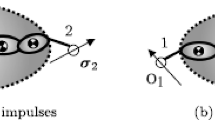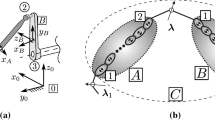Abstract
This paper presents a new mathematical framework to extend the Generalized Divide-and-Conquer Algorithm (GDCA) for the inverse dynamics analysis of fully actuated constrained multibody systems. Inverse-GDCA (iGDCA) is a highly parallelizable method which does not create the mass and Jacobian matrices of the entire system. In this technique, generalized driving forces and constraint loads due to kinematic pairs are clearly and separately differentiated from each other in the equations of motion. As such, it can be easily used for control scheme purposes. iGDCA works based on a series of recursive assembly and disassembly passes to form and solve the equations governing the inverse dynamics of the system. Herein, the mathematical formulations to efficiently combine the dynamics of consecutive bodies in the assembly pass for the purpose of inverse dynamics analysis are presented. This is followed by generating the disassembly pass algorithm to efficiently compute generalized actuating forces. Furthermore, this paper presents necessary mathematical formulations to efficiently treat the inverse dynamics of multibody systems involving kinematic loops with various active and passive boundary conditions. This is followed by the design of a new strategy to efficiently perform the assembly–disassembly pass in these complex systems while avoiding unnecessary computations. Finally, the presented method is applied to selected open-chain and closed-chain multibody systems.













Similar content being viewed by others
References
Anderson, K.S.: Recursive derivation of explicit equations of motion for efficient dynamic/control simulation of large multibody systems. PhD thesis, Stanford University (1990)
Armstrong, W.W.: Recursive solution to the equations of motion of an \(n\)-link manipulator. In: Fifth World Congress on the Theory of Machines and Mechanisms, vol. 2, pp. 1342–1346 (1979)
Bae, D.S., Haug, E.J.: A recursive formation for constrained mechanical system dynamics: part I, open loop systems. Mech. Struct. Mach. 15(3), 359–382 (1987)
Bhalerao, K.D., Poursina, M., Anderson, K.S.: An efficient direct differentiation approach for sensitivity analysis of flexible multibody systems. Multibody Syst. Dyn. 23(2), 121–140 (2010)
Brandl, H., Johanni, R., Otter, M.: A very efficient algorithm for the simulation of robots and similar multibody systems without inversion of the mass matrix. In: IFAC/IFIP/IMACS Symposium, Vienna, Austria, pp. 95–100 (1986)
Chadaj, K., Malczyk, P., Fraczek, J.: Efficient parallel formulation for dynamics simulation of large articulated robotic systems. In: 20th International Conference on Methods and Models in Automation and Robotics, MMAR 2015, Mikedzyzdroje, Poland, August 24–27, 2015, pp. 441–446 (2015). doi:10.1109/MMAR.2015.7283916
Dasgupta, B., Mruthyunjaya, T.: A Newton–Euler formulation for the inverse dynamics of the Stewart platform manipulator. Mech. Mach. Theory 33(8), 1135–1152 (1998). doi:10.1016/S0094-114X(97)00118-3
Di, Z.M., Kang, B.: An inverse dynamic model of over-constrained parallel kinematic machine based on Newton–Euler formulation. J. Dyn. Syst. Meas. Control 136(3), 041001 (2014)
Haug, E.J., Ehle, P.E.: Second-order design sensitivity analysis of mechanical system dynamics. Int. J. Numer. Methods Eng. 18, 1699–1717 (1982)
Featherstone, R.: The calculation of robotic dynamics using articulated body inertias. Int. J. Robot. Res. 2(1), 13–30 (1983)
Featherstone, R.: Robot Dynamics Algorithms. Kluwer Academic, New York (1987)
Featherstone, R.: A divide-and-conquer articulated body algorithm for parallel \({O}(\log(n))\) calculation of rigid body dynamics. Part 1: basic algorithm. Int. J. Robot. Res. 18(9), 867–875 (1999)
Featherstone, R.: A divide-and-conquer articulated body algorithm for parallel \({O}(\log(n))\) calculation of rigid body dynamics. Part 2: trees, loops, and accuracy. Int. J. Robot. Res. 18(9), 876–892 (1999)
Featherstone, R.: Rigid Body Dynamics Algorithms. Springer, New York (2007)
Fumagalli, A., Masarati, P.: Real-time inverse dynamics control of parallel manipulators using general-purpose multibody software. Multibody Syst. Dyn. 22(1), 47–68 (2009). doi:10.1007/s11044-009-9153-7
Hollerbach, J.M.: A recursive Lagrangian formulation of manipulator dynamics and a comparative study of dynamics formulation complexity. IEEE Trans. Syst. Man Cybern. SMC-10(11), 730–736 (1980)
Hollerbach, J.M., Sahar, G.: Wrist-partitioned, inverse kinematic accelerations and manipulator dynamics. Int. J. Robot. Res. 1, 152–161 (1983)
Jain, A.: Unified formulation of dynamics for serial rigid multibody systems. J. Guid. Control Dyn. 14(3), 531–542 (1991)
Jain, A., Vaidehi, N., Rodriguez, G.: A fast recursive algorithm for molecular dynamics simulation. J. Comput. Phys. 106(2), 258–268 (1993)
Kane, T.R., Levinson, D.A.: The use of Kane’s dynamical equations in robotics. Int. J. Robot. Res. 2(3), 3–21 (1983)
Kane, T.R., Levinson, D.A.: Dynamics: Theory and Application. McGraw-Hill, New York (1985)
Kingsley, C.: Efficient computation of inverse dynamics for computed torque control of multibody systems. Master’s thesis, University of Arizona (2015)
Kingsley, C., Poursina, M.: Computed torque control of articulated multibody systems in the generalized divide and conquer algorithm framework. In: ASME 2015 International Design Engineering Technical Conferences and Computers and Information in Engineering Conference, 27th Conference on Mechanical Vibration and Noise, DETC2015-46853, Boston, MA (2015)
Kreutz-Delgado, K., Jain, A., Rodriguez, G.: Recursive formulation of operational space control. Int. J. Robot. Res. 11(4), 320–328 (1992)
Laflin, J., Anderson, K.S., Khan, I.M., Poursina, M.: Advances in the application of the divide-and-conquer algorithm to multibody system dynamics. J. Comput. Nonlinear Dyn. 9, 041003 (2014). doi:10.1115/1.4026072
Laflin, J., Anderson, K.S., Khan, I.M., Poursina, M.: New and extended applications of the divide-and-conquer algorithm for multibody dynamics. J. Comput. Nonlinear Dyn. 9, 041004 (2014). doi:10.1115/1.4027869
Laflin, J.J., Anderson, K.S., Hans, M.: Enhancing the Performance of the DCA When Forming and Solving the Equations of Motion for Multibody Systems, pp. 19–31. Springer, Cham (2016). doi:10.1007/978-3-319-30614-8_2
Lewis, F.L., Dawson, D.M., Abdallah, C.T.: Robot Manipulator Control: Theory and Practice. Marcel Dekker, New York (2003)
Luh, J.S.Y., Walker, M.W., Paul, R.P.C.: On-line computational scheme for mechanical manipulators. J. Dyn. Syst. Meas. Control 102, 69–76 (1980)
Malczyk, P., Fraczek, J.: Lagrange multipliers based divide and conquer algorithm for dynamics of general multibody systems. In: Proceedings of the ECCOMAS Thematic Conference—Multibody Systems Dynamics, Warsaw, Poland (2009)
Malczyk, P., Frączek, J.: Molecular dynamics simulation of simple polymer chain formation using divide and conquer algorithm based on the augmented Lagrangian method. Proc. Inst. Mech. Eng., Proc., Part K, J. Multi-Body Dyn. (2014). doi:10.1177/1464419314549875
Malczyk, P., Janusz Fraczek, J.C.: Parallel index-3 formulation for real-time multibody dynamics simulations. In: Proceedings of the 1st Joint International Conference on Multibody System Dynamics, Lappeenranta, Finland (2010)
Masarati, P.: Computed torque control of redundant manipulators using general-purpose software in real-time. Multibody Syst. Dyn. 32(4), 403–428 (2013). doi:10.1007/s11044-013-9377-4
Mukherjee, R., Anderson, K.S.: A logarithmic complexity divide-and-conquer algorithm for multi-flexible articulated body systems. J. Comput. Nonlinear Dyn. 2(1), 10–21 (2007)
Mukherjee, R., Anderson, K.S.: An orthogonal complement based divide-and-conquer algorithm for constrained multibody systems. Nonlinear Dyn. 48(1–2), 199–215 (2007)
Mukherjee, R.M., Anderson, K.S.: Efficient methodology for multibody simulations with discontinuous changes in system definition. Multibody Syst. Dyn. 18, 145–168 (2007)
Mukherjee, R.M., Bhalerao, K.D., Anderson, K.S.: A divide-and-conquer direct differentiation approach for multibody system sensitivity analysis. Struct. Multidiscip. Optim. 35, 413–429 (2007)
Mukherjee, R.M., Crozier, P.S., Plimpton, S.J., Anderson, K.S.: Substructured molecular dynamics using multibody dynamics algorithms. Int. J. Non-Linear Mech. 43(10), 1040–1055 (2008). Non-linear Mechanics and Dynamics of Macromolecules
Neilan, P.E.: Efficient computer simulation of motions of multibody systems. PhD thesis, Stanford University (1986)
Poursina, M., Anderson, K.S.: An extended divide-and-conquer algorithm for a generalized class of multibody constraints. Multibody Syst. Dyn. 29(3), 235–254 (2012). doi:10.1007/s11044-012-9324-9
Poursina, M., Anderson, K.S.: Canonical ensemble simulation of biopolymers using a coarse-grained articulated generalized divide-and-conquer scheme. Comput. Phys. Commun. 184(3), 652–660 (2013). doi:10.1016/j.cpc.2012.10.029
Poursina, M., Bhalerao, K.D., Flores, S., Anderson, K.S., Laederach, A.: Strategies for articulated multibody-based adaptive coarse grain simulation of RNA. Methods Enzymol. 487, 73–98 (2011)
Poursina, M., Khan, I., Anderson, K.S.: Model transitions and optimization problem in multi-flexible-body modeling of biopolymers. In: Proceedings of the ASME International Design Engineering Technical Conferences & Computers and Information in Engineering Conference, no. DETC2011-48386 (2011)
Roberson, R.E., Schwertassek, R.: Dynamics of Multibody Systems. Springer, Berlin (1988)
Rosenthal, D.: An order n formulation for robotic systems. J. Astronaut. Sci. 38(4), 511–529 (1990)
Rosenthal, D.E., Sherman, M.A.: High performance multibody simulations via symbolic equation manipulation and Kane’s method. J. Astronaut. Sci. 34(3), 223–239 (1986)
Rudas, I.J., Toth, A.: Efficient recursive algorithm for inverse dynamics. Mechatronics 3(2), 205–214 (1993). Special Issue Mechatronics in Hungary. doi:10.1016/0957-4158(93)90051-3
Stepanenko, Y., Vukobratović, M.: Dynamics of articulated open-chain active mechanisms. Math. Biosci. 28(1), 137–170 (1976). doi:10.1016/0025-5564(76)90099-7
Vaidehi, N., Jain, A., Goddard, W.A.: Constant temperature constrained molecular dynamics: the Newton–Euler inverse mass operator method. J. Phys. Chem. 100(25), 10,508–10,517 (1996)
Vereshchagin, A.F.: Computer simulation of the dynamics of complicated mechanisms of robot-manipulators. Eng. Cybern. 12(6), 65–70 (1974)
Vukobratovic, M., Kircasnki, N.: Implementation of highly efficient analytical robot models on microcomputers. In: Theory and Practice of Robots and Manipulators (1985)
Walker, M.W., Orin, D.E.: Efficient dynamic computer simulation of robotic mechanisms. J. Dyn. Syst. Meas. Control 104, 205–211 (1982)
Author information
Authors and Affiliations
Corresponding author
Rights and permissions
About this article
Cite this article
Kingsley, C., Poursina, M. Extension of the divide-and-conquer algorithm for the efficient inverse dynamics analysis of multibody systems. Multibody Syst Dyn 42, 145–167 (2018). https://doi.org/10.1007/s11044-017-9591-6
Received:
Accepted:
Published:
Issue Date:
DOI: https://doi.org/10.1007/s11044-017-9591-6




